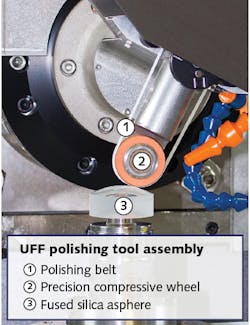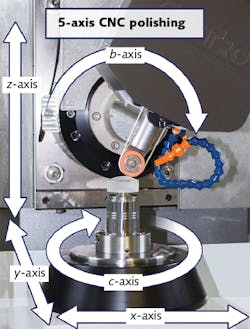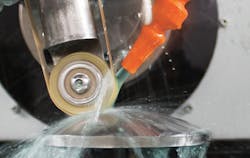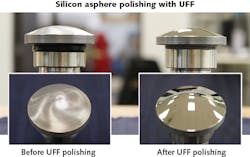Optical Manufacturing: Polishing aspheres: Spanning the scale of material hardness
Aspheric optical components, such as lenses and mirrors, have become prevalent in optical systems because of their advantages over spherical optics. Aspheric components have surface inflections that allow for good performance by minimizing spherical aberration. While surface inflections increase performance, they also increase the degree of difficulty to manufacture these parts. Because of the departure from a best-fit sphere, computer numerically controlled (CNC) polishing technology is necessary to efficiently polish precision aspheric components.
One CNC approach, called UltraForm Finishing (UFF), is a deterministic polishing process that involves a moving belt of polishing material wrapped around a precision compressive wheel (see Fig. 1). UFF is a subaperture polishing technique, meaning the polishing tool (the UFF belt) comes in contact with only a small area of the surface. Five axes of computer-controlled motion provide the ability for the polishing tool to maintain constant contact with the aspheric surface.
For rotationally symmetric aspheres, continuous rotation of the workpiece spindle allows for efficient material removal (see Fig. 2). The UFF process is driven by software that enables deterministic polishing of aspheric surfaces in two ways: by characterizing a removal function and performing uniform removal over the surface, or by performing iterative corrections based on imported metrology data.The wheel component of the UFF polishing tool is made of a compliant material and can be manufactured to various diameters and durometers (durometer is a measure of material hardness). The belt that surrounds the wheel may be bound with abrasive materials, such as cerium oxide (CeO) and diamond, or made of a polyurethane material traditionally used in optical polishing. Belts bound with abrasive materials are paired with coolant to yield optimal results, while polyurethane belts operate with loose abrasive slurry. By having the option of different wheel specifications, in conjunction with the choice of an assortment of belts, the operator can control how much material is removed during polishing.
In addition to being able to control material removal, the variety of belt configurations with UFF gives it the flexibility to polish a wide range of materials, from soft optical glasses to much harder technical ceramics. Because of this, designers of an optical system have the freedom to choose from many materials for their aspheric component, depending on the application, and be confident in the manufacturability of the component. By selecting the best UFF belt and coolant or slurry, companies can polish aspheric optical components to the desired surface finish specification down to 10 Å RMS.
Polishing materials of varied hardness
There are many factors that go into selecting the ideal material for an optical system, including thermal properties, optical properties, and mechanical properties. For the purposes of this article, the focus will be on how mechanical properties, specifically Knoop hardness, affect the UFF polishing process for aspheric optical components. Polishing “recipes” will be presented for three materials that vary in Knoop hardness: fused silica (500), silicon (1150), and silicon carbide (2500).
Fused silica is an entirely synthetic material crafted from silicon gas or silica sand (noncrystalline) and has good ultraviolet (UV) performance, making it ideal for applications such as UV transmitting optics.1 Fused silica has a Knoop hardness of 500, which is relatively soft when compared to other infrared (IR) materials or technical ceramics. This lends itself well to polishing with UFF. Operators can polish aspheric components directly after the grinding stage and achieve high removal rates and precision surfaces. The combination of a CeO belt and coolant yields the best results when polishing fused silica. This also holds true for other optical glasses, such as S-TIH53 made by Ohara or N-BK 7 made by Schott. The typical surface finish for polishing aspheric components made from fused silica and other optical glasses is 10 Å.
Silicon is used in a variety of IR applications operating in the 1.2–7 μm wavelength range, including near-IR imaging or IR spectroscopy.2 Silicon, with a Knoop hardness of 1150, is significantly harder than fused silica—an important consideration when polishing this material. It is also much harder than other IR materials that are conducive to a machining method called single-point diamond turning (SPDT). SPDT involves using a lathe that is equipped with a single point of synthetic diamond as the cutting tool. For certain materials, this can be an effective method to achieve high-precision aspheric surfaces. Because of the hardness of silicon, however, SPDT is not an ideal solution because a single point of synthetic diamond makes up the entire tool surface. Silicon quickly wears out expensive diamond-tipped tooling used on a SPDT machine and needs to be changed frequently, which delays the overall process and increases consumable costs.Silicon carbide (SiC) is among the hardest of ceramics and retains hardness and strength at elevated temperatures, which also translates into among the best wear resistance.3 These properties make the material ideal for applications such as telescope mirrors. With a Knoop hardness of 2500, SiC is more than twice as hard as silicon.
As a general rule, the harder the material being polished, the more difficult it is to remove material from the surface. UFF overcomes this challenge through the use of several diamond belts with fixed abrasive sizes ranging from 45 down to 0.5 μm, as well as a polyurethane belt for final polishing. By using a range of fixed abrasive belts and finishing with a polyurethane belt, efficient material removal is achieved throughout the entire process while limiting the amount of tool wear experienced during each polishing stage. The coarser 45 μm diamond belts are applied to the beginning of the UFF polishing process. Subsequently, finer diamond belts are utilized depending on the surface finish needed. To achieve a surface finish of around 5 nm RMS, the UFF process should conclude with a correction run using a polyurethane belt with loose abrasive slurry.
Enabling materials for any application
The application of an optical system plays an important role in the material that should be used for the aspheric optical components that reside in the system. Whether an application falls in the UV, visible, or IR region of the electromagnetic spectrum, there is a material that can be selected to yield optimal performance.
Every material is unique and possesses different mechanical properties. When looking to produce high-precision aspheric surfaces with efficiency, the Knoop hardness of the material being polished can eliminate certain manufacturing methods from consideration. The flexibility to configure UFF polishing tools with different belts and wheels allows optical manufacturers to polish a wide range of materials, from softer optical glasses to extremely hard technical ceramics.
REFERENCES
1. See https://goo.gl/JRoQ53.
2. See https://goo.gl/YCy6ke.
3. See https://goo.gl/se7T1Y.
About the Author
Pat Bechtold
Marketing Technologist, OptiPro Systems
Pat Bechtold is Marketing Technologist at OptiPro Systems (Ontario, NY).
Jayson Tierson
Director of Technology Solutions, OptiPro Systems
Jayson Tierson is Director of Technology Solutions at OptiPro Systems (Ontario, NY).



